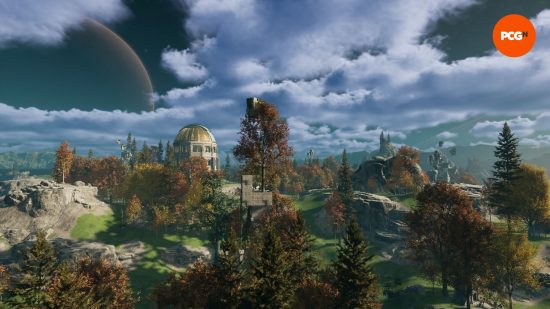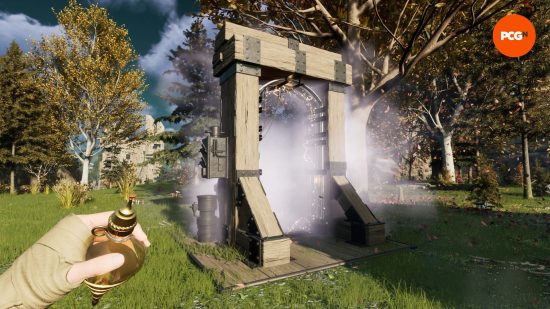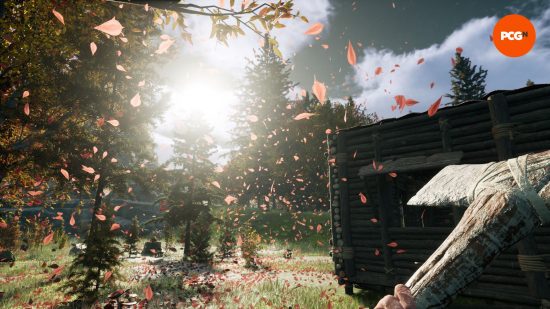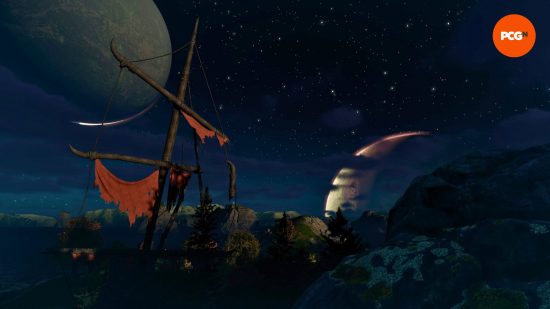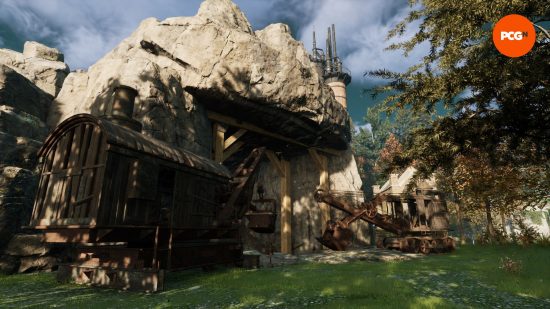Last week, I got a chance to play Nightingale, a new survival-crafting game with a heavy Victorian Gaslamp aesthetic and more than a few mythic curios. It comes from Inflexion Games, which includes some former Bioware staff who worked on Mass Effect and Dragon Age. The basic loop will be familiar to anyone who has brushed against the genre in recent years; build a base, craft tools, and explore. Where Nightingale aims to stand apart, though, is that this busywork is surrounded by a world full of wonder and a story that, quite literally, goes places.
Nightingale‘s aesthetic grabs me from the word go; thick wool suits, dandy umbrellas, and heaving mustaches. It’s a perfect look for the ‘frontier’ type of exploration the survival game promises. Throw in a story about Fae creatures revealing themselves and changing the course of history itself and I’m sold. The Fae introduced magick (spelled with a ‘k’ so you know it’s serious) to humans and spurred on an unprecedented era of technological advancement.
You’re immediately thrown into a situation far beyond your means, and survival looks bleak. You’ve been displaced from your home, the traditional portal network people use to get about has been sundered, and humanity has been sprinkled across who-knows-where. You’re saved from a grisly fate by a Fae creature named Puck, who takes you through a tutorial, and then on to a relatively calm realm where you can set up a base of operations. The ultimate aim, I’m told, is to get back to the city of Nightingale, which is a sort of retro-futuristic version of Paris. To do this, you’ll have to traverse the Realms, taking on the various dangers within, and crafting a lot of gear.
The aforementioned Realms are accessed by using Realm Cards; a collection of tarot-like items that, when used in a realm portal, conjure a gateway. Where you’ll end up, though, is down to you, with each combination of Realm Cards slightly tweaking your destination.
There are three types of Realm Cards: Biome, Major, and Minor, with the Biome and Major cards dictating your overall destination. A mixture of Desert and Abeyance cards, for instance, will conjure a desert realm with little danger, but if you swapped that Abeyance card for an Antiquarian, get ready for a fight. The Minor Cards are used in-realm to change the rules slightly; want to reduce gravity to make exploration safer? There’s a Thinly Veiled card for that. Need a ton of wood for that building project? The Lumber Mill card will do the trick.
The Minor Cards can be used in-game and will visibly change your surroundings with no downtime or cutscenes. It looks fantastic, as does the rest of Nightingale. The forests are thick, the deserts skin-cracking-ly dry, and the swamps heave with atmosphere. The environmental storytelling is on point, with rusted automatons and gargantuan skulls littering the land, teasing events of the past that you’ll never know. There are currently three biomes to visit, which may not seem like much, but they’re distinct both in how they look and what they contain.
The choose-your-own-adventure aspect of exploration is fascinating and drives progress forward naturally. I wanted to discover and craft new cards to see what I could conjure, and with the procedural generation coming into play, it meant that no two realms I visited were the same, even if the cards I used were. The Realms I opened were inhabited by NPCs with a host of problems. Problems I could usually solve by crafting and occasionally hitting things on the head with the items I just crafted.
This is where Nightingale began to wear thin, at least for me. The malaise I have towards crafting games has increased after playing both Palworld and Enshrouded, which isn’t the fault of Nightingale, but I fear this may leak into the game’s overall reception. While the universe is novel, and I do want to know the fate of my Realmwalker, the sheer amount of faff I have to go through to get there wasn’t encouraging.
Gathering so many resources only for them to be crafted into other resources, building a crafting table, and then getting another shopping list wasn’t the most rewarding of loops. There was so much I wanted to see, but instead, I was at home waiting for my leather hides to finish at my Tanning Station.
The best compliment I can pay Nightingale is that I proceeded despite the crafting. I cared very little about increasing the power level of an item, but very much about Puck and whatever eldritch horror I’d encounter on my next jaunt. Sadly, these experiences are gated behind your ‘Gear Rating,’ and do require a large amount of environmental decimation to gather the appropriate ingredients to increase said rating.
My efforts didn’t amount to much beyond some increased gear stats. Combat was essentially the same from when I began to when I finished; it’s a relatively floaty affair, similar to Skyrim, keeping a distance from my foe and cracking them about the head when the chance arrived. It doesn’t feel overly satisfying, and while I have seen all manner of firearms available for those much later in the game, I was stuck with nothing but my maul and a plucky attitude.
When I began my journey, my character was clad in a rather lovely-looking adventurers suit, ready for whatever the world could throw at him. It wasn’t long before I was funneled into crafting a few sets of more powerful gear, though. This gear had me looking like a slightly unhinged caveman who got dressed in the dark. Nightingale, in the beginning at least, has the same problem Destiny players faced many moons ago; when your gear has a number attached, you have to wear the ‘best’ you have, rather than the most aesthetically pleasing, meaning you’ll quickly end up looking like a rodeo clown instead of the intrepid Realmwalker the game claims you are.
This hunt for new and improved equipment continued for the next few hours, as I had to increase my gear rating to further explore the world. Each milestone I hit was met with another, with no end in sight, and it left me a little exhausted. Hitting rocky outcrops with my level 40 pickaxe only to glimpse at another piece of ore that required something with a 240 power level drained motivation, rather than inspiring improvement. I was told in a press presentation that there’s a meaty endgame here, with raid-like encounters and a whole new hub area, but getting there from the point of a newbie seemed to be an ordeal.
Inflexion Games recently told our very own Nat Smith that they’re planning on putting community first with Nightingale, and while that is an excellent way to approach this type of game, I’m a little worried that the overall experience for the solo player will suffer. The drip-fed story means players are forced to subsist in these realms on vibe alone, and with the amount of busywork you’ll be doing, it’ll be interesting to see if that’s enough.
Nightingale will be a thoroughly enjoyable experience for those who are already sold on the methodical nature of crafting games. An intriguing story, gorgeous visuals, and genuine discovery are the reward for your efforts. I worry, though, that the constant grind of improvement may turn people off before they have a chance to experience the best of what Nightingale has to offer. It’s going to be in Steam Early Access for around a year, so there is plenty of time to refine what Inflexion Games already has here: solid foundations, but still a ways to go.

